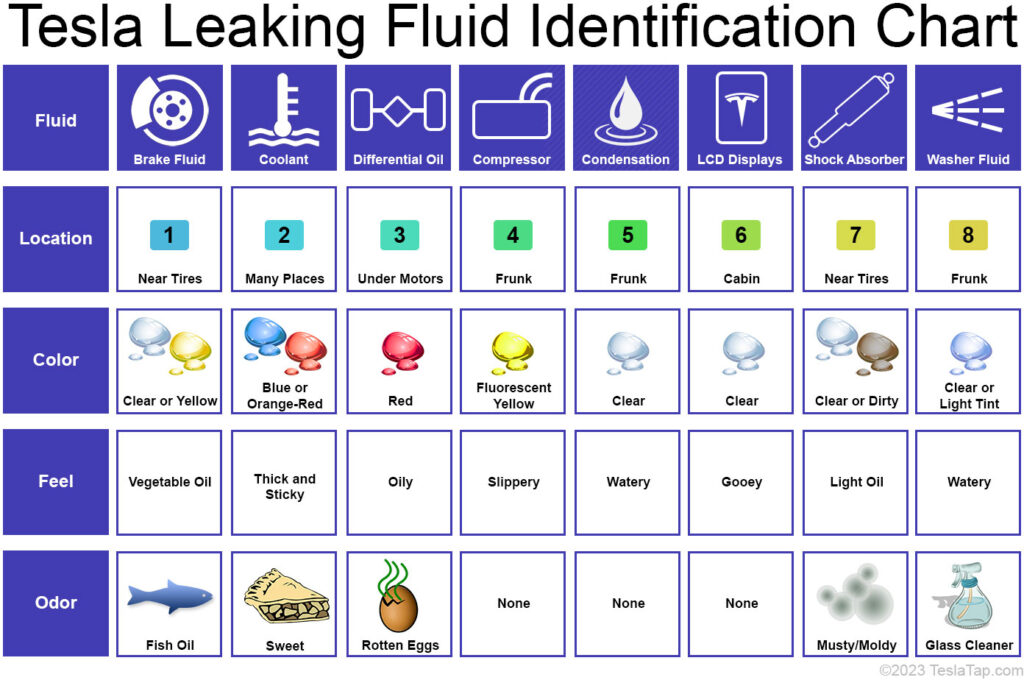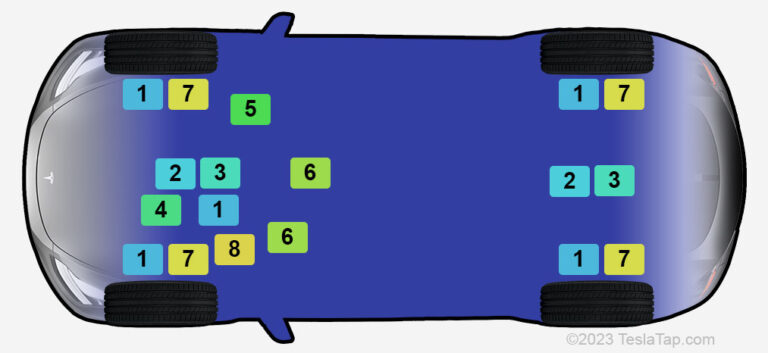

Do you see something dripping from your Tesla or a stain under your car in the driveway? We’ll show how to check which fluid drips or puddles may be normal or those that may indicate a critical failure. (Feb-2023)
Identification Chart
Use this chart to identify fluids you may find on your Tesla S/X/3/Y. Location of drips and puddles is approximate, and due to under body panels, leaks may seep out at different locations.

Drip Locations

Fluid Types
Brake Fluid
Brake fluid has a reservoir near the firewall with lines out to each wheel. Leaks are quite rare but could occur down the front firewall or lines going to each wheel. Tesla recommends checking the fluid every 2 years and replacing if necessary. If the vehicle is used for towing, it should be replaced every 2 years.
Brake fluid is highly toxic, so be careful with cleanup and disposal. Brake fluid will also damage painted surfaces. Clean with a mix of car shampoo and water and use disposable absorbent cloths.
Do not drive your vehicle if you discover a brake leak until the problem is corrected.
Coolant
The glycol coolant is contained in a reservoir in the frunk area under service panels. Coolant is fed through pumps and valves in the frunk area. Lines run to the battery pack, front motor (if equipped), rear motor, MCU/AP processor (all 3/Y; 2021+ S/X LR & Plaid), the cabin air handler, and the charger (older vehicles) or Power Conversion Module (newer vehicles).
Note that Tesla does not consider the coolant to be a owner replaceable fluid, and any damage caused by opening or filling the battery coolant reservoir is excluded from the warranty.
If there are no warnings on the display, it should be safe to drive short distances. The vehicle will shutdown if the battery and motors cannot be properly cooled or heated for lack of coolant.
Differential/Transmission Oil
Each Drive Unit (DU) includes a differential and a single speed transmission as part of the assembly. Tesla uses a synthetic oil to cool and lubricate these gears. Oil can leak from a failed seal. This is a sealed system that should not leak for the life of the car, but vehicles with a lot of miles and age could develop a failed seal.
Any oil leaks should be addressed before a lack of oil creates damage and/or makes the vehicle inoperable.
Generally, Tesla service does not repair the drive unit assembly, but exchanges the DU for a rebuilt unit.
HVAC Compressor Oil
The HVAC compressor has oil to lubricate the compressor and circulates through the compressor lines. It is fairly rare to have this oil leak, but it means the refrigerant is leaking and will ultimately lead to failure of the HVAC system and even destroying the compressor. This leak typically drips in the front center of the vehicle. For the S/X/3 without the heat pump it could appear inside the cabin condenser, but this is exceptionally rare fault.
These types of leaks may be more visible using an UV light source.
HVAC Condensation
When the HVAC runs, it often creates water that drips out the bottom of the car near the firewall. You may see a water puddle under the car. This is normal.
LCD Displays
A thick fluid is sandwiched in front of each display on older Model S/X with MCU1 (Vehicles made before March 2018). If the seal fails on the instrument cluster or main screen, the goo slowly leaks out and bubbles form on the display. While it has little affect to the visibility of the display, the only fix is to replace the screen. An MCU2 Retrofit is often cheaper than replacing both screens, as it includes improved screens as part of the retrofit.
In extreme cases, the goo leaks out under the dash. To clean the goo, use alcohol wipes.
Shock Absorber Hydraulic Fluid
Each shock absorber contains a small amount of hydraulic fluid. As it leaks out, dirt will usually quickly accumulate to make it quite dirty looking. Some seepage is normal and expected. If the shock has failed, most of the shock absorber will be covered in fluid, but it may not be enough to drip beyond the shock absorber.
You should avoid touching hydraulic fluid as it can be absorbed through the skin and cause irritation. If you do have contact, the skin area should be washed immediately with soap and water.
Washer Fluid
The washer fluid reservoir is in the frunk area. It can be accessed once the frunk is open. The reservoir has a small pump attached and lines that run to the windshield sprayer. If a line becomes disconnected, when you activate the washer, it may spray fluid into the frunk area and drip out under the frunk area of the vehicle.
Error Messages
Some low level fluid conditions may provide a error message on the display or in the secondary service menu.
Brake fluid level is low (MCU_w005_BrakeFluidLow)
Limited A/C and Battery Cooling – There can be multiple causes, but low refrigerant and compressor oil could cause this error.
Vehicle Coolant is Low: Contact Tesla Service (THC_w0105_coolantBottleLowLevel)
Window washer fluid is low (MCU_u002_washerFluidLow)
To access the secondary service menu, select Controls -> Software. Press and hold the larger text “Model” for 5 seconds and then release. A dialog “Please enter access code” will appear. Type “service” (all lowercase). Proceed to service mode. Tap the button “Service Alerts”. Note that there are often service alerts that are unimportant. Here are some errors that are critical:
BMS_f142_SW_Isolation_Degradatio
BMS_w034_SW_Isolation_Sensor
BMS_w035_SW_Isolation
BMS_w123_SW_Internal_Isolation
BMS_w151_SW_external_isolation
These errors indicate the vehicle needs immediate service. It could be due to leak inside the battery pack or DU, but may be caused by other issues too. When these errors occur, the car may request you pull over safety (if driving) and will not restart.
Internal Leaks
Battery Pack
Coolant lines run through the battery pack to ensure the cells are at the optimum temperature. Should the coolant leak into the BMS (Battery Management System) electronics or the batteries, it would cause a failure of the pack. This is exceptionally rare unless the pack is physically damaged, such can occur in a significant accident.
It is also possible that after many years a seal on the pack fails and lets water (rain, etc.) into the pack. Older pack designs were not as robust and failures have occurred, especially with the earliest designs made in 2015 and older.
While there are no fluid leak detectors in the pack, the system detects these types of pack failures by BMS failures or any significant resistance between the isolated high voltage and the battery pack’s metal enclosure.
Tesla service will replace the failed pack with a factory refurbished pack if available or more often recently with a new pack.
Drive Unit
The Drive Unit (DU) assembly is comprised of the motor, inverter electronics and the differential/transmission. The motor and inverter is cooled by the glycol coolant. The differential/transmission uses oil to lubricate and cool those portions. There are areas of the motor and inverter that are in air.
The three areas – air, oil and coolant should ever mix. If one of the seals should fail that protects each area from the other, it cause the DU to fail. This type internal leakage failure is not visible external to the DU.
Normally Tesla service will replace the failed DU rather than attempt a repair. This may be replaced with a factory refurbished DU or a new DU.
Similar to the battery pack, the system monitors the resistance of the motor’s isolated high voltage and the motor casing. If it detects lower resistance than expected, it usually indicates an internal leakage issue.
Will Leaks Happen?
While EVs in general are designed not to leak for a lifetime, there are many contributors to why a leak may happen.
- Accidents – Clearly if something is damaged, it can easily cause a catastrophic leak. In rare cases, after major accident repairs, if other damaged parts were not replaced slow leaks may occur.
- Age – Rubber and some plastics can deteriorate with age. These parts can become brittle and/or crack causing leaks.
- Design – Parts can be poorly designed, using the wrong materials and/or unable to withstand the tough automotive environment. The LCD displays used from about 2013 through 2018 fall into this category.
- Manufacturing – A manufacturing error occurs where parts are not assembled correctly or a defective part is used. This can cause a leak, often very early in the life of the vehicle, that might not be detected when built.
- Temperature – Under extreme temperatures or frequent temperature changes can be stressful on some parts. Temperature can be a contributor to other issues that cause leaks.
- Vibration and Wear – Parts that are subject to high vibration and/or wear over a long period can cause a leak event.